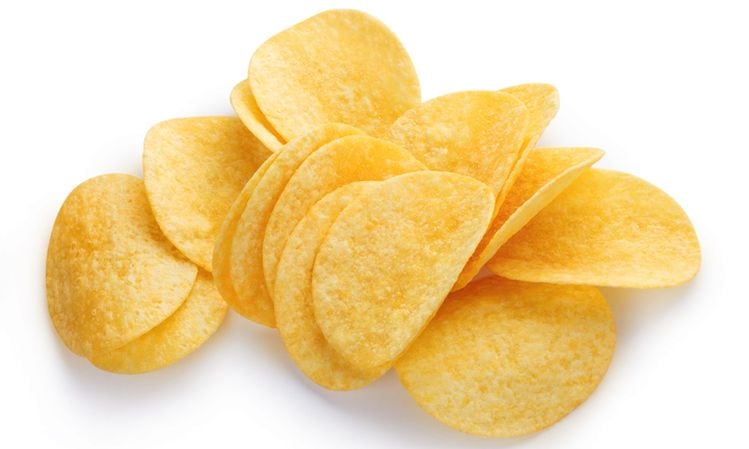VIDEO: 3D image of the microstructure of potato chip made from potato flakes determined by X-ray micro-computed tomography.
The study - published in the journal Nature Food - “resulted from a collaboration between ourselves [researchers at KU Leuven University in Flanders, Belgium], scientists from the Kellogg Company, and to a lesser extent, Yangzhou University,” co-author Jan Delcour, PhD, a professor of food science at KU Leuven, told FoodNavigator-USA.
“The work is an excellent example of the triple helix approach to innovation in which academia, industry, and a government agency [Flanders Innovation & Entrepreneurship] collaborate to create value for society.”
The fine structure of extractable amylose in potato flakes dictates oil uptake
The researchers focused on deep-fried chips such as Pringles that are manufactured from sheets of dough made from potato flakes (rather than regular potato chips made from thinly sliced whole potatoes).
They found that the fine structure of extractable amylose (a type of starch) in potato flakes dictates oil uptake during frying, and thus their caloric density.
“We found that higher levels of short extractable amylose chains increase dough strength,” said Dr Delcour.
“The strong amylose networks in these dough sheets slow down water evaporation during deep-frying, which in turn reduces product expansion and oil uptake.”
Basically, he observed, any approach that would result in an increased level of short extractable amylose chains in potato flakes should result in these effects.
“One way of doing so, as shown in the Nature Food publication, is by selecting potato flakes that already contain high levels of these extractable amylose chains.” [The reason why some flakes contain higher levels is twofold, he said: specific potato cultivars may contain higher levels, while the potato flake production process may induce the release of more of these chains into the extracellular space.]

Another way of doing it is to selectively alter the extractable amylose chains by using amylases (enzymes that hydrolyze starch) to tailor the structure of amylose in potato flakes, he said.
‘Reducing the fat content of the crisps from 33% to 21% reduces their caloric density to 479 kcal/100 g, i.e. a calorie reduction of 11%.’
So what does this mean in practice?
“In our work, the lipid [fat] content of potato crisps prepared from different potato flakes ranged from 21% to 33% of crisp dry matter and was related to the structure of the extractable amylose in the flakes,” he said.
“Hence, using the right potato flake samples allowed us to reduce oil uptake during deep-frying by 36%.”
So how does this translate to the Nutrition Facts panel? “Commercial Pringles available in the supermarket have a lipid content of about 33%, which yields a caloric density of 540 kcal/100g,” he said.
“Reducing the fat content of the crisps from 33% to 21% reduces their caloric density to 479 kcal/100 g, i.e. a calorie reduction of 11%.”
Reduced fat Pringles already on the market deploy a different approach
But hasn’t Kellogg already brought out reduced fat Pringles?
“Pringles with 25% less fat, which are available in the marketplace in the USA, are perceived as ‘harder’, as shown by consumer trials,” explained co-author Stefaan Matthijs, research & innovation manager, salted snacks, at Kellogg (based in Ghent, Belgium).
“However, the production of Reduced Fat Pringles relies on a different approach than the one proposed in our Nature Food paper. Their production relies on… a pre-treatment of potato flakes and altered processing conditions. These technologies substantially raise the production costs for making these fat reduced crisps.
“In contrast, we believe that reducing Pringles fat content based on insight in the impact of the structure of extractable amylose in potato flakes is a more valuable approach.”
Broader implications of the research, from pasta to mashed potatoes
Dr Delcour added: “Our Nature Food paper is the first to link the strength of the starchy gel structure in dough sheets to their drying kinetics and heat-induced transformations during deep-frying, and how they relate to product texture and lipid content.
“This paper… provides guidelines for lowering the lipid content and for tailoring the texture of potato crisps by selecting potato cultivars that contain high contents of short amylose chains, as well as production parameters dictating their extractability.”
The findings could also translate to other food products made from potato flakes, he speculated.
“The broader concepts presented in our paper, i.e. how starch network formation is impacted by amylose chain length distribution, may even hold true for all food products in which starch network formation is of importance, from bakery products, to pasta, (fresh) mashed potatoes, and so on.”
“Some techniques optimized in this research paper are highly novel in this research area. The present work showed that X-ray micro-computed tomography (μCT) is a powerful tool to examine the microstructure and oil distribution in deep-fried products. Furthermore, in-situ 1H NMR analysis during deep-frying has, to the best of our knowledge, never been reported on before.”
Source: Reyniers, S., De Brier, N., Ooms, N. et al. Amylose molecular fine structure dictates water–oil dynamics during deep-frying and the caloric density of potato crisps. Nature Food 1, 736–745 (November 2020). https://doi.org/10.1038/s43016-020-00180-x
